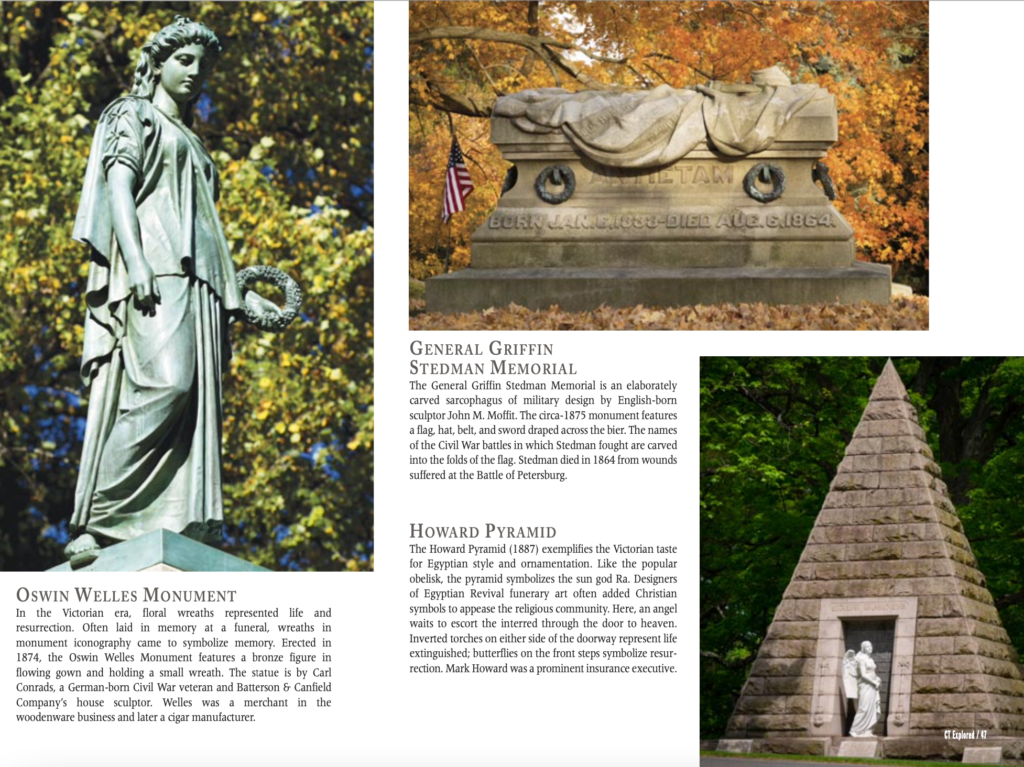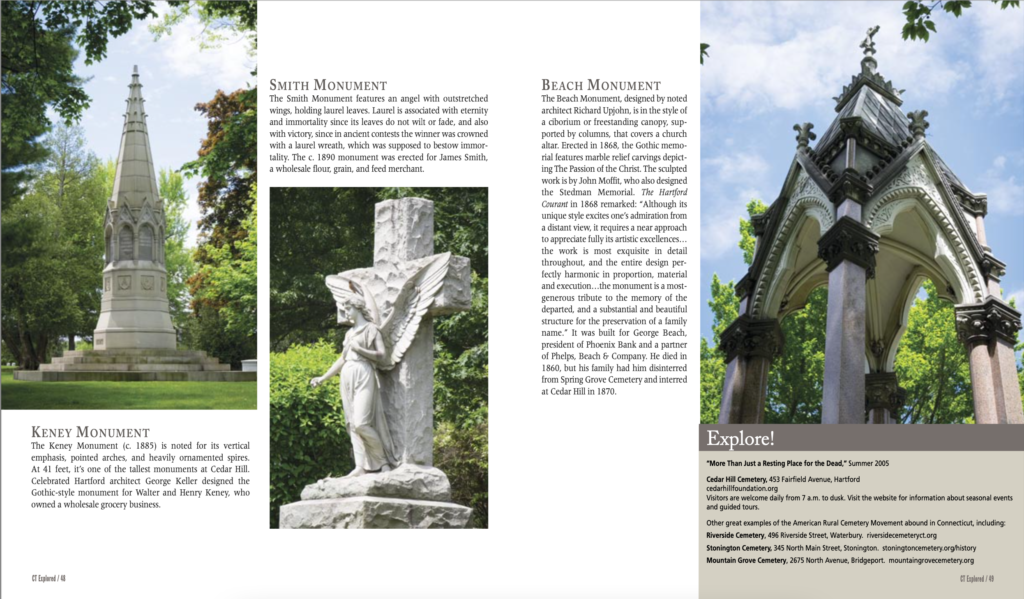By Beverly Lucas
(c) Connecticut Explored Inc. Fall 2021
Subscribe/Buy the Issue!
Established in 1864, in the midst of the Civil War, Cedar Hill Cemetery in Hartford encompasses 270 acres of landscaped memorial grounds designed by Jacob Weidenmann. In the Victorian era, cemeteries began to serve a larger purpose—to not only meet the needs of the deceased, but to satisfy the living through their peace and beauty. Known as rural cemeteries, their essential features include being located away from the city center, designed in a park-like manner, and governed by a private board of directors.
Cedar Hill’s monuments are creative expressions of 19th-century funerary art. They reflect the wealth and status of Victorian Hartford and those who chose to be buried in its new, fashionable cemetery. Here are a few outstanding examples.
In the Victorian era, floral wreaths represented life and resurrection. Often laid in memory at a funeral, wreaths in monument iconography came to symbolize memory. Erected in 1874, the Oswin Welles Monument features a bronze figure in flowing gown and holding a small wreath. The statue is by Carl Conrads, a German-born Civil War veteran and Batterson & Canfield Company’s house sculptor. Welles was a merchant in the woodenware business and later a cigar manufacturer.
General Griffin Stedman Memorial
The General Griffin Stedman Memorial is an elaborately carved sarcophagus of military design by English-born sculptor John M. Moffit. The circa-1875 monument features a flag, hat, belt, and sword draped across the bier. The names of the Civil War battles in which Stedman fought are carved into the folds of the flag. Stedman died in 1864 from wounds suffered at the Battle of Petersburg.
Howard Pyramid
The Howard Pyramid (1887) exemplifies the Victorian taste for Egyptian style and ornamentation. Like the popular obelisk, the pyramid symbolizes the sun god Ra. Designers of Egyptian Revival funerary art often added Christian symbols to appease the religious community. Here, an angel waits to escort the interred through the door to heaven. Inverted torches on either side of the doorway represent life extinguished; butterflies on the front steps symbolize resurrection. Mark Howard was a prominent insurance executive.
The Keney Monument (c. 1885) is noted for its vertical emphasis, pointed arches, and heavily ornamented spires. At 41 feet, it’s one of the tallest monuments at Cedar Hill. Celebrated Hartford architect George Keller designed the Gothic-style monument for Walter and Henry Keney, who owned a wholesale grocery business.
Smith Monument
The Smith Monument features an angel with outstretched wings, holding laurel leaves. Laurel is associated with eternity and immortality since its leaves do not wilt or fade, and also with victory, since in ancient contests the winner was crowned with a laurel wreath, which was supposed to bestow immortality. The c. 1890 monument was erected for James Smith, a wholesale flour, grain, and feed merchant.
Beach Monument
The Beach Monument, designed by noted architect Richard Upjohn, is in the style of a ciborium or freestanding canopy, supported by columns, that covers a church altar. Erected in 1868, the Gothic memorial features marble relief carvings depicting The Passion of the Christ. The sculpted work is by John Moffit, who also designed the Stedman Memorial.The Hartford Courant in 1868 remarked: “Although its unique style excites one’s admiration from a distant view, it requires a near approach to appreciate fully its artistic excellences…the work is most exquisite in detail throughout, and the entire design perfectly harmonic in proportion, material and execution…the monument is a most generous tribute to the memory of the departed, and a substantial and beautiful structure for the preservation of a family name.” It was built for George Beach, president of Phoenix Bank and a partner of Phelps, Beach & Company. He died in 1860, but his family had him disinterred from Spring Grove Cemetery and interred at Cedar Hill in 1870.
Beverly Lucas is the director of Cedar Hill Cemetery Foundation.
Explore!
“More Than Just a Resting Place for the Dead,” Summer 2005
Cedar Hill Cemetery, 453 Fairfield Avenue, Hartford
cedarhillfoundation.org
Visitors are welcome daily from 7 a.m. to dusk. Visit the website for information about seasonal events and guided tours.
Other great examples of the American Rural Cemetery Movement abound in Connecticut, including:
Riverside Cemetery, 496 Riverside Street, Waterbury
riversidecemeteryct.org
Stonington Cemetery, 345 North Main Street, Stonington
stoningtoncemetery.org/history
Mountain Grove Cemetery, 2675 North Avenue, Bridgeport
mountaingrovecemetery.org
“Grave Deeds and Abandoned Cemeteries,” Summer 2019
Hartford’s Ancient Burying Ground: “Unburying Hartford’s Native and African Family Histories,” Fall 2019
“Beauty in a Gravestone” Winter 2010/2011
“Benjamin Collins, Rock Star,” Spring 2015
GO TO NEXT STORY
SUBSCRIBE/BUY THE ISSUE!


